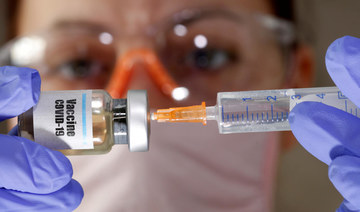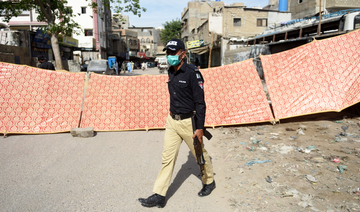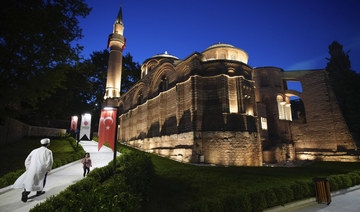DUBAI: Saudi Ministry of Human Resources and Social Development said private sector employees will be able to return to their offices soon as the Kingdom starts easing COVID-19 regulations.
Dubai’s government said that 50 percent of government workers will return to their office on Sunday, and aims for a 100 percent resumption starting June 14.
Oman has also asked government entities to ensure that at least 50 percent of their workforce is back to offices as of Sunday.
May 28, 2020, Thursday (All times in GMT)
19:55 - Dubai is reopening four beaches and major parks to the public starting Friday, Dubai Media Office reported.
19:10 - Kuwait has extended the suspension of work across all government agencies until further notice.
17:50 - Kuwait eases full-time coronavirus curfew to 12-hour ones from 6 p.m. to 6 a.m.
17:30 - President Erdogan said on Thursday Turkey will lift intercity travel restrictions on June 1, will keep stay-at-home restrictions in place for over 65s and restaurants and cafes to reopen June 1 also.
16:30 - Groups of up to 6 people will be able to meet outside in England from Monday if they maintain social distancing, Britain's Prime Minister Boris Johnson said on Thursday as he confirmed that tests had been met to ease the coronavirus lockdown further.
14:23 - Iraq announced three new deaths from COVID-19 bringing the death toll in the country to 179.
14:00 - New York City mayor Bill de Blasio said on Thursday the first phase of reopenings in the city will include construction, manufactuing, wholesale suppliers and non-essential retail. He expects 200,000-400,000 people to return to work during the first phase.
13:40 - Philippines President Rodrigo Duterte on Thursday approved a recommendation to ease the lockdown in the capital Manila from June 1, resuming much-needed activity in an economy on the brink of recession.
Strict restrictions on commerce and movement since mid-March have ravaged the economy, which is facing its deepest contraction in 34 years.
13:16 - Qatar announced 1,967 new cases of COVID-19 on Thursday.
12:37 - Saudi Arabia’s Ministry of Health announced 16 more deaths from COVD-19, 1,644 new cases of the disease and 3,531 new cases of recovery from it on Thursday.
11:25 – Two Fulham players have tested positive for coronavirus in the latest round of testing, the Championship club announced.
10:54 – A partial reopening of Danish schools did not lead to an increase in coronavirus infections among young students, a doctor of infectious disease epidemiology and prevention at the Danish Serum Institute said on Thursday, citing new data.
10:28 – International tourism is set to fall by 70 percent this year, marking the sector’s biggest slump since records began in the 1950s, United Nations World Tourism Organization Secretary-General Zurab Pololikashvili told newspaper Handelsblatt.
10:18 – Kuwait has confirmed 845 new coronavirus cases, increasing total caseload to 24,112. There were also 752 new recoveries, bringing the total number of recovered patients to 8,698.
10:14 – UAE has detected 563 new coronavirus cases, bringing the total number of infected people to 32,532.
08:53 – Indonesia reported 687 new coronavirus cases, bringing the total number of infections in the Southeast Asian country to 24,538, a health ministry official said. Indonesia also confirmed 23 new deaths from the virus, bringing the total fatalities to 1,496, the official, Achmad Yurianto, told reporters. As of Thursday, Indonesia has tested 201,311 people and 6,240 patients have recovered.
08:41 – Russia said its death toll from the coronavirus has risen above 4,000 as the daily toll equalled a record set earlier this week.
08:21 – Finland has seen no evidence of the coronavirus spreading faster since schools started to reopen in the middle of May, the top health official said. “The time has been short, but so far we have seen no evidence,” Mika Salminen, director of health security at the Finnish Institute of Health and Welfare, told a news conference. Finland started to reopen schools and daycare centres from May 14 following an almost two-month shutdown.
08:16 – The Philippines’ health ministry reported 17 more novel coronavirus deaths and 539 new infections, the largest number of cases reported in a single day since the virus was first detected in the country.
06:51 – GlaxoSmithKline will expand production of vaccine efficacy boosters, or adjuvants, to produce 1 billion doses in 2021 for use in shots for COVID-19.
06:36 – Singapore jailed a taxi driver for four months on Wednesday over a Facebook post in which he falsely claimed food outlets would close and urged people to stock up due to impending COVID-19 restrictions.
06:26 – Moderna has extended a deal to secure large volumes of the lipids used to produce its experimental COVID-19 vaccine in a bid to meet increasing demand for the medicine, the US biotech company said on Thursday.
04:51 – Thailand reported 11 new coronavirus cases and no new deaths, bringing its total to 3,065 confirmed cases and 57 fatalities since the outbreak started in January.
The cases were Thai nationals in quarantine who recently returned from overseas, including four from Kuwait, six from Qatar, and one from India, said Taweesin Wisanuyothin, a spokesman for the government’s coronavirus task force.
04:08 – As the coronavirus spreads into indigenous lands in Brazil, killing at least 40 people so far by the government’s count, the first two COVID-19 deaths were registered this week in the Xingu area, one of the biggest reserves in the world.
03:29 – South Korea reported its biggest spike in coronavirus cases in nearly two months, as officials scramble to tackle fresh clusters that have raised concerns of a possible second wave of infections.



























